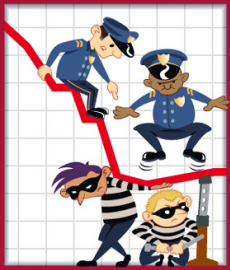
Having considered the impact that changes in legislation and police recording style have on the Official Statistics, it is also important to consider what Quetelet had understood from the beginning. That is, that not all crimes will be recorded, meaning that there is a ‘dark figure’ in crime statistics. The phenomenon of some crimes not being recorded is known as ‘attrition’, and there are many stages throughout the process of going through the criminal justice system that this can occur.
To begin, some crimes will not even be reported. This can be because the participants are too scared to come forward, and this is the reason that we hear about most in the media. This is particularly common in cases of serious assault, since victims may feel ashamed of what has happened to them, or they may be worried about what the offender will do to them if they find out about them reporting the crime. This problem may be solved if relationships between community and police are improved so that people have better trust in the police, and also by campaigning for those who have been victimised in this way to come forward about it. Some victims simply think that the crime that has taken place may be too trivial to report and think that the police will not care or won’t want to help with the issue. Furthermore, if victims know the criminal in another capacity, such as if they are a family member or romantic partner, they may have mixed feelings about reporting the crime, since though they don’t want it to happen again, they do not want to see the person responsible punished.
While this is a serious issue, it is not the only reason why victims may not report crimes to police. In some cases, the victims just aren’t aware that a crime has taken place. For example, many of us just don’t read our bank statements carefully enough to see where our money is going, and if £30 went missing here and there, we may not notice. Another reason why crimes are not reported is that some crimes have ‘no victim’. In the buying and selling of drugs, both participants are technically criminals, and though the drug user is in many ways a victim, they have made the choice to buy the drugs. Therefore there is no one to report the crime to the police. Because of this, the Official Statistics will vastly underrepresent the amount of drug crime that is going on each year.
Finally, some crimes will not reach Official Statistics because of the decisions that police officers make with regards to how to proceed. Police officers may reject that a crime has taken place or the victim’s account and there may be insufficient evidence to take the crime any further. In these cases, if a crime really has taken place, it will go under the radar. Some police may decide not to look into certain crimes, since it adds to their workload, and will make it harder for them to reach targets. This is of course an extreme failure of their responsibility, but many consider the main problem to be the stressful targets that are put on the police force in the UK which can lead to them acting in an inappropriate way. The Official Statistics can be useful for the police in their work as they offer a measurement of how quickly crimes are ‘cleared up’. This refers to the speed at which crimes are dealt with and all required actions are taken. However, as discussed above, often police are set high clear up rates as targets and this can lead to them neglecting their duties as officers of the law.
Having noted these limitations with the Official Statistics, how can we improve our knowledge of the crime that is taking place and test for the accuracy of the Official Statistics? The answer may be in a separate method of statistics, known as Victimisation Surveys.
For those who want to know more about Official Crime Statistics in the UK and what sorts of information they contain, the most recent publications can be found online at http://www.homeoffice.gov.uk/publications.
Image from: https://brianrobertssociology.files.wordpress.com/2013/04/crime-stats.jpg

0 Comment:
Be the first one to comment on this article.